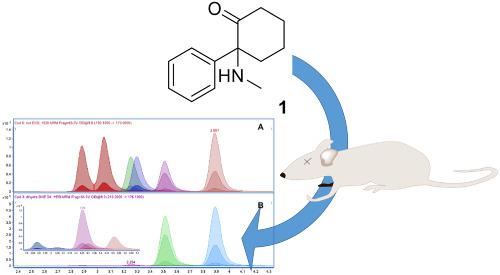当前位置:
X-MOL 学术
›
Drug Test. Anal.
›
论文详情
Our official English website, www.x-mol.net, welcomes your
feedback! (Note: you will need to create a separate account there.)
Synthesis and identification of deschloroketamine metabolites in rats' urine and a quantification method for deschloroketamine and metabolites in rats' serum and brain tissue using liquid chromatography tandem mass spectrometry.
Drug Testing and Analysis ( IF 2.6 ) Pub Date : 2020-01-15 , DOI: 10.1002/dta.2726 Kateřina Hájková 1, 2, 3 , Bronislav Jurásek 1, 4, 5 , Jan Čejka 6 , Kristýna Štefková 5 , Tomáš Páleníček 5, 7 , David Sýkora 2 , Martin Kuchař 1, 4, 5
Drug Testing and Analysis ( IF 2.6 ) Pub Date : 2020-01-15 , DOI: 10.1002/dta.2726 Kateřina Hájková 1, 2, 3 , Bronislav Jurásek 1, 4, 5 , Jan Čejka 6 , Kristýna Štefková 5 , Tomáš Páleníček 5, 7 , David Sýkora 2 , Martin Kuchař 1, 4, 5
Affiliation

|
Deschloroketamine (2‐(methylamino)‐2‐phenyl‐cyclohexanone) is a ketamine analog belonging to a group of dissociative anesthetics, which have been distributed within the illicit market since 2015. However, it was also being sold as ‘ketamine' misleading people to believe that they were getting genuine ketamine. Dissociative anesthetics have also come to the attention of the psychiatric field due to their potential properties in the treatment of depression. At present, there is a dearth of information on deschloroketamine related to its metabolism, biodistribution, and its mechanism of action. We have therefore carried out a metabolomics study for deschloroketamine via non‐targeted screening of urine samples employing liquid chromatography combined with high‐resolution mass spectrometry. We developed and validated a multiple reaction monitoring method using a triple quadrupole instrument to track metabolites of deschloroketamine. Furthermore, significant metabolites of deschloroketamine, (trans‐dihydrodeschloroketamine, cis‐ and trans‐dihydronordeschloroketamine, and nordeschloroketamine), were synthesized in‐house. The prepared standards were utilized in the developed multiple reaction monitoring method. The quantification method for serum samples provided intra‐day accuracy ranging from 86% to 112% with precision of 3% on average. The concentrations of cis/trans‐dihydronordeschloroketamines and trans‐dihydrodeschloroketamine were lower than 10 ng/mL, nordeschloroketamine and deschloroketamine ranged from 0.5 to 860 ng/mL in real samples. The quantification method for brain tissue provided intra‐day accuracy ranging from 80% to 125% with precision of 7% on average. The concentrations of cis/trans‐dihydronordeschloroketamines and trans‐dihydrodeschloroketamine ranged from 0.5 to 70 ng/g, nordeschloroketamine and deschloroketamine varied from 0.5 to 4700 ng/g in real samples.
中文翻译:

液相色谱-串联质谱法在大鼠尿液中合成和鉴定脱氯氯胺酮代谢物,并定量测定在大鼠血清和脑组织中的脱氯氯胺酮和代谢物。
脱氯氯胺酮(2-(甲基氨基)-2-苯基-环己酮)是一种氯胺酮类似物,属于一组解离麻醉剂,自2015年以来已在非法市场中销售。但是,它也被作为“氯胺酮”误导性人群而出售。相信他们正在服用真正的氯胺酮。分离麻醉药由于其在抑郁症治疗中的潜在特性,也引起了精神病学界的关注。目前,关于脱氯氯胺酮的代谢,生物分布及其作用机理的信息还很少。因此,我们通过液相色谱与高分辨率质谱联用对尿液样品进行非靶向筛查,进行了脱氯氯胺酮的代谢组学研究。我们开发并验证了使用三重四极杆仪器跟踪脱氯氯胺酮代谢物的多反应监测方法。此外,脱氯氯胺酮的重要代谢物,(反式-dihydrodeschloroketamine,顺式-和反式-dihydronordeschloroketamine和nordeschloroketamine),内部合成。所制备的标准品已用于开发的多反应监测方法中。血清样品定量方法的日内准确度范围为86%至112%,平均准确度为3%。在实际样品中,顺式/反式-二氢去氯氯胺酮和反式-二氢去氯氯胺酮的浓度均低于10 ng / mL,去甲氯氯胺酮和去氯氯胺酮的浓度范围为0.5至860 ng / mL。脑组织的定量方法提供的日内准确度范围为80%至125%,平均准确度为7%。浓度实际样品中,顺式/反式-二氢去氯氯胺酮和反式-二氢去氯氯胺酮的范围为0.5至70 ng / g,去甲氯氯胺酮和去氯氯胺酮的范围为0.5至4700 ng / g。
更新日期:2020-01-15
中文翻译:

液相色谱-串联质谱法在大鼠尿液中合成和鉴定脱氯氯胺酮代谢物,并定量测定在大鼠血清和脑组织中的脱氯氯胺酮和代谢物。
脱氯氯胺酮(2-(甲基氨基)-2-苯基-环己酮)是一种氯胺酮类似物,属于一组解离麻醉剂,自2015年以来已在非法市场中销售。但是,它也被作为“氯胺酮”误导性人群而出售。相信他们正在服用真正的氯胺酮。分离麻醉药由于其在抑郁症治疗中的潜在特性,也引起了精神病学界的关注。目前,关于脱氯氯胺酮的代谢,生物分布及其作用机理的信息还很少。因此,我们通过液相色谱与高分辨率质谱联用对尿液样品进行非靶向筛查,进行了脱氯氯胺酮的代谢组学研究。我们开发并验证了使用三重四极杆仪器跟踪脱氯氯胺酮代谢物的多反应监测方法。此外,脱氯氯胺酮的重要代谢物,(反式-dihydrodeschloroketamine,顺式-和反式-dihydronordeschloroketamine和nordeschloroketamine),内部合成。所制备的标准品已用于开发的多反应监测方法中。血清样品定量方法的日内准确度范围为86%至112%,平均准确度为3%。在实际样品中,顺式/反式-二氢去氯氯胺酮和反式-二氢去氯氯胺酮的浓度均低于10 ng / mL,去甲氯氯胺酮和去氯氯胺酮的浓度范围为0.5至860 ng / mL。脑组织的定量方法提供的日内准确度范围为80%至125%,平均准确度为7%。浓度实际样品中,顺式/反式-二氢去氯氯胺酮和反式-二氢去氯氯胺酮的范围为0.5至70 ng / g,去甲氯氯胺酮和去氯氯胺酮的范围为0.5至4700 ng / g。











































 京公网安备 11010802027423号
京公网安备 11010802027423号